There’s a lot to cover on Wednesdays. We should know, as collectively, we read an insane amount of comics. Even with a large review staff, it’s hard to get to everything. With that in mind, we’re back with Wrapping Wednesday, where we look at some of the books we missed in what was another great week of comics.
Let’s get this party started.
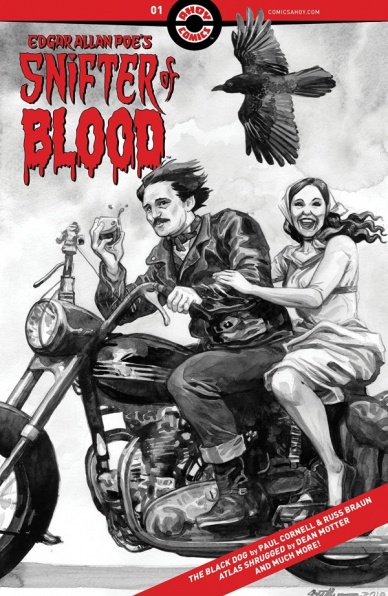
Written by Paul Cornell, Dean Motter, Brendan Mallory, Matthew Sharpe, & Reed Beebe
Illustrated by Russ Braun, Dean Motter, Rob Steen, Molly Stanard, & Ed Catto
Colored by Andy Troy and Julie Barclay
Lettered by Rob Steen and Dean Motter
Reviewed by Elias Rosner
Now entering its third volume, with a brand new title, “Edgar Allen Poe’s Snifter of Blood” #1 is a reminder that the horror anthology is not dead, and if anything, it’s back from the dead with a vengeance. Two comic stories, an editor’s note, and three short, prose work, as with most AHOY titles, you’re really getting your money’s worth. The central conceit is alive and well in this issue and drunk Poe remains a fun horror host.
As for the quality of the stories, “Snifter of Blood” #1 is well constructed. The first story, “The Black Dog” plays with Poe’s story “The Black Cat,” capturing the innocence and naivety of a dog while poking fun at Poe’s original story and the lengths to which Poe would go to justify the mood of his original stories. The second story, “Atlas Shrugged” is weaker, showcasing a restrained story that isn’t particularly interesting, perhaps because it’s riffing on a work I’m not familiar with. The art is also restrained but it works better than the story, perhaps because it is kept simple and clear, evoking the Victorian era without relying on smoky streets and dark alleyways.
Earlier, I said this was a horror anthology but really “Snifter of Blood” is a comedy book with a horror theme. Many horror stories have a touch of the comedic, of the absurd, and this is true of the comics in “Snifter of Blood.” They are either outright “MAD-Esque” parody or satire or just plain absurd. This is really where “Atlas Shrugged” struggles and why it isn’t as strong a story. The humor is obtuse and played as a straight “horror” story, it is lacking in that undercurrent of fear or amoral, were it to be a morality play. The ending reads as lackluster and abrupt and the usual eleventh-hour twist in those old EC comics isn’t impactful or even present. It’s an otherwise well-told story; it’s just missing that spark.
There are also three fun prose stories, “Finally” being the strongest, but those are often a bonus rather than the main attraction. That said, the cumulative effect of solid prose and solid comic stories, even if one is weaker, makes for an anthology issue that is worth reading and easy to pick up.
Final Verdict: 7.6 – “Snifter of Blood” #1 is another fun installment in the anthology series. Pick it up if you’re looking for chills, thrills, and a bit of a chuckle in this, the spooky season.

Written by Christopher Cantwell
Illustrated by Cafu
Colored by Frank D’Armata
Lettered by VC’s Joe Caramagna
Reviewed by Alexander Jones
It is difficult to express just how important tone is in an “Iron Man” comic book. With so much exposure on this character, a new writer on the “Iron Man” property has to succeed with a measure of humor and drama. Writer Christopher Cantwell captures the grounded tone of the films surprisingly well while taking the time to introduce the greater Marvel Universe. Tony Stark is aware of some of the cliches and repetitions in his previous relationships and actively references them with Patsy Walker. A classic Marvel villain has also revealed in the first couple of pages of the issue. Cantwell isn’t afraid of tapping numerous villains for the course of one issue while juggling the greater narrative of Stark trying to reinvent himself and find who he is as Iron Man (again.)
Continued belowCafu’s linework in the issue is sparse but effective. The issue packs minimalistic detail but is able to render a lot of expressions. The characters are clear and the action draws the attention of the eye naturally. Cafu’s art is able to capture the most expression during the action scenes. The issue has a phenomenal fight sequence with Tony punching through iron. I thoroughly enjoyed the last page of the series that carried a dramatic page composition with a wonderful panel bleed. Seeing the experimentation in some of the bolder sequences made me wish Cafu packed the rest of the issue with the same passion. Aside from the detail lacking in the issue, the other major drawback to the art is Frank D’Armata’s colors. D’Armata’s colors appear flat in the first few pages of the issue. Towards the end of the book, the hues in the hospital make the setting look too clinical.
I can’t stress the importance of the little details in the issue that account for a greater whole. Stark’s jokes about health insurance add a grounded aesthetic to the book that should resonate with fans of the character from the films. Cantwell really has found a direction and tone that feels appropriate for Tony. I have found myself questioning the legitimacy in tone and humor from the past few Iron Man writers. Marvel’s recent talent has often portrayed Tony as too optimistic but Cantwell adds a self-deprecating sense of humor that captures Robert Downey Jr.’s performance and the character as a whole. While I wish Cafu’s line was more ambitious and portrayed more detail, the art is another solid aspect of the title.
Final Verdict: 8.1 – If Tony Stark’s self-effacing jokes in “Iron Man” #2 don’t melt your heart, Patsy Walker’s subtle jabs will.
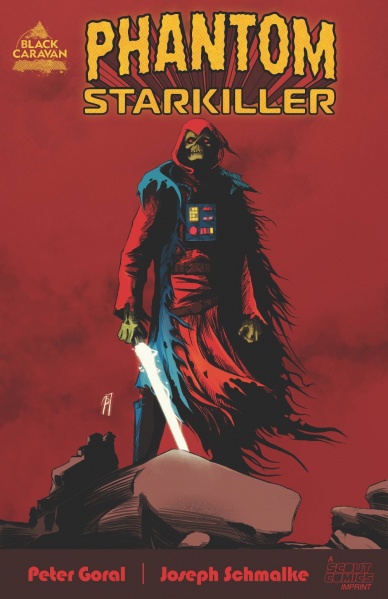
Written by Peter Goral
Illustrated by Joseph Schmalke
Colored by Peter Goral
Lettered by Joel Rodriguez
Reviewed by Jodi Odgers
Comics telling the story of toys is not a new concept, with everything from Transformers to My Little Pony sharing some part of their lore in comic form. The latest and one of the most obscure properties to continue this tradition is Phantom Starkiller, the Cosmic Ghoul Assassin.
“Phantom Starkiller” #1 shares an action-packed tale showing the titular, skeletal character attempting to retrieve an ancient MacGuffin from their universe because their cosmic overlord told them to. Given Phantom Starkiller’s striking character design, I was hoping for a bonkers tale with everything ramped up to the proverbial 11 – something that wouldn’t feel out of place in the pages of “Space Riders”.
Unfortunately, that is not what I found within “Phantom Starkiller” #1. The comic attempted to both deliver a grounded tale of a fallen protagonist hitting their lowest point and a zany space opera where said fallen protagonist uses a slew of gadgetry to kill hordes of enemies in increasingly outlandish ways. Joseph Schmalke did an admirable job bringing Phantom Starkiller to life, rendering his unique form in a captivating way. However, the dialogue and coloring from Peter Goral left a lot to be desired. It felt like there was too much text for a comic with such a visually interesting protagonist. This feeling wasn’t aided by the fact that a large portion of that text was mundane and unoriginal. The colors could also have stood to be more outlandish, more in line with the frankly awesome main cover for the issue.
Overall, “Phantom Starkiller” #1 wasn’t self-aware enough to embrace its absurdity, and its attempts at delivering eye-catching comic pages undermined any serious emotional beats.
Final Verdict: 5.9 – “Phantom Starkiller” tried to juggle competing sentiments and ended up wasting the visual potential of the titular character.
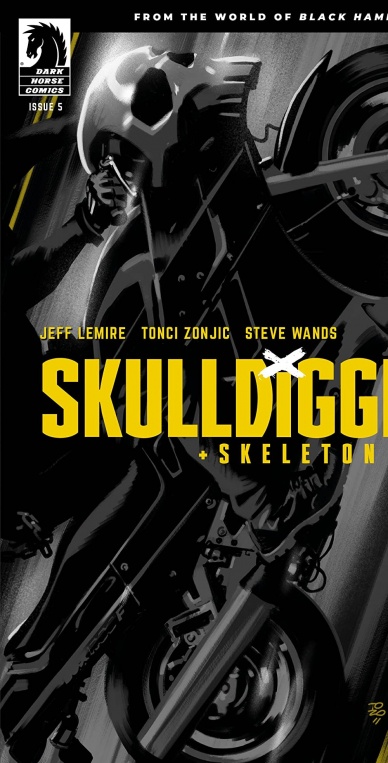
Written by Jeff Lemire
Penciled by Tonci Zonjic
Inked by Tonci Zonjic
Colored by Tonci Zonjic
Lettered by Steve Wands
Reviewed by Jason Karlson
May? The conclusion to this series is seven months away? [Editor’s Note: Dark Horse Comics later confirmed to us on Twitter that the finale to the series will be released January 2021.] As comic readers, we’ve all come up against big gaps between issues, but it’s that the penultimate issue of Spiral Cities vigilante and his kid sidekick so perfectly sets up such a perfect, edge-of-your-seat cliffhanger that makes six months sound so unbearable!
Continued belowLemire’s comic work always comes with the best “elevator pitches” to entice readers and Skulldigger is no exception to this. What if, Lemire muses, a character like Dick Grayson reeling from his parents’ violent and sudden death sees not the dark knight step out of the shadows to save him, but Frank Castle’s Punisher. It’s an exciting and intriguing premise and the series has riffed heavily on the ultra-violent “anti-hero” archetype and how we view them, touching along the way the line between them and the more obvious heroes while exploring the relationships between characters like Batman and his young wards. Where do you draw the line between heroism and the weaponization of a child’s rage and simple black and white view of justice? Skulldigger and Skeleton Boy mixes up the archetypes of characters we all know so very well and shines a spotlight on one of comics’ most established yet bizarre tropes, child sidekick. Despite the well-tread subject matter Lemire still has a new and fresh take on the matter and in five issues has delved deep into the life of street-level vigilantes.
Issue five takes a well-deserved breather from the violence and vengeance of the series so far as Detective Reyes escapes Spiral City with Skeleton Boy in tow, unsure of how to save him or what that even means anymore. Unsure of how to get through to the angry sidekick she recounts her own past and how it has been marred by the cycle of violence that Skulldigger perpetuates, giving us both a deeper insight into Reyes and re-establishing the comics core themes and ideas. Nothing is this plain and simple though and even during a brief dip in his anger when Skeleton Boy admits that despite his thirst for payback and pain, his time with the morally lacking hero has been deeply scarring, recounting being unable to shake the level of violence he has witnessed. It’s clear that neither she nor Skulldigger’s interventions in the young boy’s life are going to give him what he needs.
Tonci Zonjic is the latest artist making his mark upon the rapidly expanding Black Hammer universe and has captured both the look of modern vigilante titles with its striking touches of Dark Knight Returns to the quaint and more subdued atmosphere of fifties crime comics in flashbacks that he gives a lot more clean-cut and almost naive feel all the while maintaining his own style and never falling into lazy homage. This issue employs a much more restrained layout and palette, with duller dust red tones as Reyes and Skeleton Boy hit the deserts outside of the city. Issues five standout art moment is Skulldigger gleaming mace crashing into Reyes windshield that brings the realization that no matter who gets to her first, Skulldigger or Grimjack, the outcome is likely to be just as bloody.
Final Verdict: Lemire continues the trend established from the start of Black Hammer and shows that he has a firm grasp on the deeper lives and motivations of the characters.
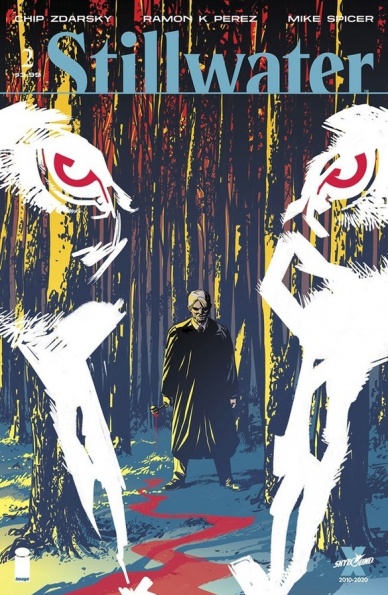
Written by Chip Zdarsky
Pencils by Ramón K Perez
Colored by Mike Spicer
Lettered by Russ Wooton
Reviewed by Quinn Tassin
As fate would have it, Heaven being a place on Earth is a pretty creepy thing. “Stillwater #2” does a pretty good job at convincing readers of that, at least. Last week, we got a taste of the mysterious town where people can’t die and with the second issue, Chip Zdarsky and Ramón K Perez do a great job teaching us more about the town of Stillwater and its inhabitants while keeping us. The actual content of the issue is simple but full. Rather than focusing on the disorientation of Daniel/Tommy (though we do get some of that), we get a lot more information about the world around them. We learn that Ted is just as gross a man as he seems and Sheriff Tanya is a good person with a strong backbone. We get a peek at the machinations of the town with its judge/jury/executioner and specific roles for all its members. This is obviously a weird place with weird people and you can’t read it without dying to know more. Also, there’s a great little monologue about Blade.
Continued belowRamón K Perez and Mike Spicer illustrate the town in a way that feels simultaneously grounded and surreal. Perez is particularly strong at making the book feel alive; there’s a clear sense of purpose as you move between panels and pages that are always present in comics but rarely this palpable. Spicer’s colors imbue the book with a hazy, dreamlike tone that goes a long way in establishing the overall feeling you get when you’re reading it. The pair does great work throughout the issue but the final four pages, which show us the walk to the town meeting and the live burial of Laura Quinn, really are special.
“Stillwater #2” is a comic that makes you feel sensations that you can’t quite describe. It’s creepy and weird and makes you feel a sense of dread while still being deeply intriguing. Getting to know this town is surely going to be a great experience and I’m already counting down to issue 3.
Final Verdict: 8.5 – “Stillwater #2” begins to unravel the secrets of the titular town to excellent results.
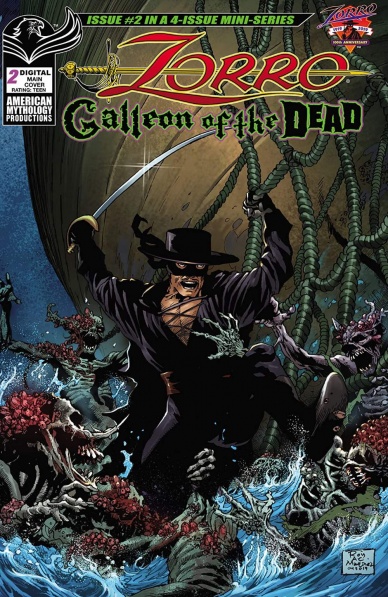
Written by Mike Wolfer
Illustrated by Allesandro Miracolo
Colored by Periya Pillai
Lettered by Natalie Jane
Reviewed by Ryan Fitzmartin
New Zorro stories being published over a hundred years after the character’s debut is incredible. This is a strong statement about the staying power of costumed adventurers. “Zorro: Galleon of the Dead” #2 written by and Mike Wolfer illustrated by Allesandro Miracolo provides plenty of action and adventure. We find Zorro as he faces off against a demonic luchador and the wrestler’s ghost ship. The phantom craft is of course filled with zombified sailors, armed to the teeth and out for blood. There’s a talking parrot, a damsel in distress, and bumbling town guards. The story and its elements would feel right at home in the pages of EC Thriller Comics in the 50s.
Miracolo’s art isn’t particularly special, aside from some nice details on the undead sailors. The artwork is competent and safe, to go along with a story that is competent and safe. “Galleon of the Dead” feels very traditional, a deliberate harkening back to a simpler age of comics. There’s no complicated story, or moral underwriting, or attempt at making a more serious comic. At it’s best, the comic reads like the weird fun of Hellboy. At its worst, it could be a reprint of something written fifty years ago. For fans of old-style, simplistic comics, there will be plenty to like in Zorro. There’s a strong, winning throwback energy here.
For anyone looking for a more engaging or intellectual experience, you will certainly be disappointed. “Zorro: Galleon of the Dead” #2 doesn’t have gorgeous art or tantalizing writing. There’s no message or any real attempts at postmodernism or diversity. Indeed a book playing its tropes and concepts so straight might elicit eye rolls from some readers. There is something to be said for a simple comic that doesn’t aim too high and simply exists to please. Zorro fans looking for nostalgic, silver age style adventures certainly will indeed be pleased.
Final Verdict: 7.4 – An action-adventure silver-age throwback, for better and for worse.






